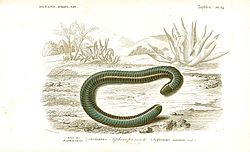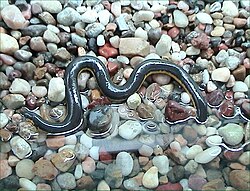Caecilian
The Caecilians are an order (Gymnophiona or Apoda) of amphibians. Most of them look like either earthworms or snakes. They burrow in the ground. For this reason, they are the least explored order of amphibians.
| Caecilians Temporal range: Jurassic – Recent
| |
|---|---|

| |
| "Caecilian" | |
| Scientific classification | |
| Kingdom: | |
| Phylum: | |
| Class: | |
| Order: | Gymnophiona Müller, 1832
|

| |
Anatomy
Caecilians have no limbs. For this reason, the smaller species look like worms, while the larger species with lengths up to 1.5 m look similar to snakes. The tail is short and the cloaca is near the end of the body. Their skin is smooth and usually dark in colour. Some species have colorful skins, though. Inside the skin are calcite scales. Due to their underground life the eyes are small. Skin often covers them, to protect them. This has led to the idea that they are blind, which is not the case. Because of the skin cover, their seeing is limited to simple dark-light perception. They can tell the difference between dark and light. All Caecilians have two tentacles at their head. The tentacles are probably used for a second smelling capability in addition to the normal sense of smell based in the nose.
Most Caecilians have lungs, except for two lungless species. Those that have lungs also use the skin or the mouth to get oxygen. Often the left lung is much smaller than the right one. This is an adaptation to the shape of the body, which is also be found in snakes.
Distribution
They are mostly distributed in the tropics of South and Central America, Africa, and South Asia. The diet of caecilians is not well known. They live in the moist, lower habitats. In South America they can be found well into the temperate north of Argentina. They can be seen as far south as Buenos Aires, when they are carried by the flood waters of the Paraná River coming from farther north. No studies have been made in central Africa, but it is likely that caecilians are found in the tropical rainforests there. The northernmost distribution is of the species Ichthyophis sikkimensis of Northern India. In Africa caecilians are found from Guinea Bissau (Geotrypetes) to Northern Zambia (Scolecomorphus). In South-East Asia the Wallace Line is not crossed, and they are not found in Australia or the islands in between. Ichthyophis is also found in South China and North-Vietnam. About 25% of the species are oviparous (egg-laying); the rest are ovoviviparous, with eggs hatching inside the mother. The eggs are guarded by the female. For some species the young caecilians are already metamorphosed when they hatch, other hatch as larvae. The larvae are not fully aquatic, but spend the daytime in the soil near the water.[1]
In ovoviviparous species the foetus is fed inside the female with special cells of the oviduct, which are eaten by the foetus with special scraping teeth. Some larvae, such as those of Typhlonectes, are born with enormous external gills which are shed almost immediately. The egg laying species Boulengerula taitanus feeds its young by developing a special outer layer of skin, which the young peel off with similar teeth. Ichthyophis is oviparous and is known to show maternal care.
Diet
The diet of caecilians is not known well, though it seems it mostly consists of insects and invertebrates found in the habitat of the respecitive species. The stomach content of 14 specimens of Afrocaecilia taitana consisted of mostly organic material and plant remains. Where identifiable remains were most abundant, they were found to be termite heads.[2] Caecilians in captivity can be easily fed with earthworms, and worms are also common in the habitat of many caecilian species.
Origin of the name
The name Caecilian derives from the Latin word caecus = blind, referring to the small or sometimes non-existing eyes. The name dates back to the taxonomic name of the first species described by Carolus Linnaeus, which he gave the name Caecilia tentaculata.
Taxonomy

Taxonomically the caecilians are divided into ten families. The species numbers are approximate and many of these species are identified on the basis of only one specimen. It is likely that not all species have been described yet, and that some of the species described below as different may be combined into one species in future reclassifications.
- Beaked Caecilians (Rhinatrematidae) – 2 genera, 9 species
- Fish Caecilians (Ichthyophiidae) – 2 genera, 39 species
- Indian Caecilians (Uraeotyphlidae) – 1 genus, 5 species
- Tropical Caecilians (Scolecomorphidae) – 2 genera, 6 species
- Aquatic Caecilians (Typhlonectidae) – 5 genera, 13 species
- Common Caecilians (Caeciliidae) – 26 genera, 99 species
The recent discovery of a tenth family in north-east India has been announced.[3]
Recent discoveries
A Swiss researcher Daniel Hofer has recently found that certain caecilians produce potent skin poisons from specialized poison glands. The poison prevents predation and the poison of the bright yellow caecilian of São Tomé Island (Schistometopum thomense) in West Africa kills other animals kept in the same tank within a few days. The chemical contents of caecilian poison have not been well studied. Werner Himstedt has shown that the skin glands of Ichthyophis protects the eggs from germs and fungi. It has also been shown that these poisons are very different from those from other amphibians such as the arrow poison frogs.
The hatchlings of the oviparous East African Boulengerula taitanus have special teeth that allow them to peel and eat their mother's skin. The mother's skin in this species was found to be thicker than normal and contained a high level of fat and other nutrients.
References
| Wikispecies has information on: Gymnophiona. |
| Wikimedia Commons has media related to Lua error in Module:Commons_link at line 62: attempt to index field 'wikibase' (a nil value).. |
- ↑ Nussbaum, Ronald A; Cogger H.G. & Zweifel R.G. eds 1998. Encyclopedia of reptiles and amphibians. San Diego: Academic Press. pp. 52–59. ISBN 0-12-178560-2
- ↑ Hebrard, J.J. (1992). "Notes on the habitat and diet of Afrocaecilia taitana". J. Herpetol. 26: 513–515.
{{cite journal}}: Cite has empty unknown parameter:|month=(help); Unknown parameter|coauthors=ignored (|author=suggested) (help) - ↑ Black, Richard 2012. New amphibian family find for India. BBC News Science/Environment [1]
- Werner Himstedt, Die Blindwühlen, ISBN 3-89432-434-1 (German)
- San Mauro, Diego; et al. (2004). "Phylogeny of caecilian amphibians (Gymnophiona) based on complete mitochondrial genomes and nuclear RAG1". Molecular Phylogenetics and Evolution. 33: 413–427.
{{cite journal}}: Cite has empty unknown parameter:|month=(help); Explicit use of et al. in:|first=(help) - San Mauro, Diego; et al. (2005). "Initial diversification of living amphibians predated the breakup of Pangaea". American Naturalist. 165: 590–599.
{{cite journal}}: Explicit use of et al. in:|first=(help)
Other websites
- Image of Grandisonia alternans, a Seychelles caecilain
- New Scientist article on Boulengerula taitanus
[[Category:Caecilians| ]
